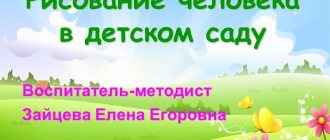Presentation on the topic: Cognitive activity of preschool children
Slide description:
Modern approaches to organizing cognitive activity of preschool children 900igr.net
Slide description:
Cognitive activity is the active activity of acquiring and using knowledge. The task of a child’s cognitive development is to develop the need and ability to think actively and overcome difficulties in solving various mental problems.
Slide description:
There are two main lines in the development of cognitive interests of preschoolers: 1. Gradual enrichment of the child’s experience, saturation of this experience with new knowledge and information about the environment, which causes the preschooler’s cognitive activity.
The more aspects of the surrounding reality that open up to a child, the wider his opportunities for the emergence and consolidation of stable cognitive interests. 2.
This line of development of cognitive interests consists of a gradual expansion and deepening of cognitive interests within the same sphere of reality.
Slide description:
2-3 years. The object of cognition is the surrounding objects and their actions. Children of this age actively explore the world according to the principle: “What I see, what I act with, that is what I learn.”
The accumulation of information occurs through the manipulation of objects, the child’s personal participation in various situations, events, and the child’s observations of real phenomena.
A necessary condition for the activity of cognition is the diversity and changeability of the subject sphere surrounding the child, the provision of freedom of exploration (subject-manipulative play), a reserve of free time and space for unfolding games. 3-4 years.
By this age, children accumulate quite a lot of ideas and knowledge about the surrounding reality. However, these ideas are practically unrelated to each other. The child is only trying to establish relationships between ideas. During this period, the foundations of the aesthetic perception of the world are laid.
Methods of sensory cognition are actively being formed, sensations and perceptions are being improved. The object of cognition becomes not only objects and their actions, but also the characteristics of objects (color, shape, size, physical qualities). This knowledge helps children compare objects and phenomena according to one sign or property and establish relationships of similarity - identity and difference, and carry out classification.
Slide description:
4-5 years. At 4 years of age, the child’s cognitive development moves to another level - higher and qualitatively different from the previous one. Speech becomes a means of cognition. The ability to accept and correctly understand information transmitted through words develops.
Cognitive activity takes on a new form; the child actively reacts to figurative and verbal information and can productively assimilate, analyze, remember and operate with it. Children's vocabulary is enriched with words and concepts. 5-6 years. The older preschooler is already learning about the “big world.”
The basis of a child’s attitude to the world is caring, kindness, humanity, and compassion. Children can already systematize accumulated and received information, through logical operations, establish connections and dependencies, location in space and time.
The sign-symbolic function of consciousness develops, that is, the ability to use signs to indicate actions, signs, and build a model of logical relationships between concepts.
Slide description:
Game is the leading activity of preschool children, on which the entire educational process of a preschool institution is based.
Play for a child is a serious activity in which we create the most favorable conditions for general mental, including intellectual and personal development.
Play is cognitive development, social development, physical development, artistic and aesthetic development, mental development and health.
Slide description:
The organization of cognitive classes depends, on the one hand, on the educational program objectives, and on the other hand, on the content structure of the cognitive activity itself.
Since game motivation in cognitive activity is leading throughout preschool age, a game form of cognitive classes and the active use of game techniques during the lesson are recommended.
Slide description:
Organization of joint cognitive activity of the teacher and children The main forms of organization of children's cognitive activity in this block are didactic and plot-didactic games.
Working with children within this block excludes specially organized classes.
The activity of children can be caused by a teacher who involves them in cognitive and play activities, demonstrating his own passion for it.
Slide description:
Organization of independent cognitive activity of children Within the framework of this block, the creative activity of children develops in cognitive and play activities, free experimentation with various materials. The child gets the opportunity for self-realization.
As part of free independent activity, children master the ability to act in a group of peers, cooperate with them, enter into competitive relationships, and implement elements of a specific children's subculture that are necessary for the child's prosperous existence in the children's community.
The function of the teacher in this block is to create a varied play environment that provides the child with cognitive activity that corresponds to his interests and is developmental in nature.
The environment should also provide children with the opportunity to act individually or together with peers, without imposing mandatory joint activities.
Slide description:
Our children receive the development of cognitive processes - they learn to read, write and count, - they are introduced to creativity and educational work, - they become familiar with beauty, - they love to draw, design and sculpt, - they confidently communicate with peers and adults, - they are actively involved in physical exercises, - they become involved in to a healthy lifestyle.
Slide description:
Thank you for your attention
Source: //ppt4web.ru/detskie-prezentacii/poznavatelnaja-dejatelnost-doshkolnikov.html
Report “Cognitive development of preschool children in the context of the implementation of the Federal State Educational Standard for Education”
Cognitive development of children is one of the important areas in working with preschool children. A child is born with an innate cognitive orientation that helps him adapt to new conditions of his life. Gradually, cognitive orientation develops into cognitive activity - a state of internal readiness for cognitive activity, manifested in children in search actions aimed at obtaining new impressions about the world around them. As the child grows and develops, his cognitive activity increasingly begins to gravitate towards cognitive activity.
The cognitive development of a preschool child as an evolutionary process goes through several stages: curiosity, inquisitiveness, the stage of development of cognitive interest, the stage of development of cognitive activity, which move from lower to higher in the joint activity of a significant adult and a child.
So, at the stage of curiosity
The preschooler is content with only the initial orientation associated with the interestingness, brightness, and unusualness of the object itself.
Curiosity
represents a valuable state of the individual, an active vision of the world, characterized by the desire of a preschool child to penetrate beyond the boundaries of what was initially seen and perceived. At this stage, strong emotions of surprise, joy of learning, delight, and satisfaction with the activity are manifested.
A new quality of cognitive development of preschool children is cognitive interest.
, characterized by increased stability, clear selective focus on a cognizable object, valuable motivation in which cognitive motives occupy the main place; cognitive interest contributes to the preschooler’s penetration into essential relationships, connections, and patterns of mastering reality.
cognitive activity to be a high level of cognitive development of preschool children
, the basis for the development of which is the holistic act of cognitive activity.
The source of cognitive activity is the cognitive need
, and the process of satisfying this need is carried out as a search aimed at identifying, discovering the unknown and assimilating it.
As recommended types of activities that ensure the cognitive development of preschool children, we highlight:
– organization of solving cognitive problems;
– the use of experimentation in the work of subsidiaries;
– use of design.
When working with preschoolers, cognitive tasks are used,
which are understood as educational tasks that presuppose the presence of search knowledge, methods (skills) and stimulation of the active use of connections, relationships, and evidence in learning. A system of cognitive tasks accompanies the entire learning process, which consists of sequential activities that gradually become more complex in content and methods.
Examples of cognitive tasks may include the following:
Inanimate nature
: Why do tree branches sway? Why are there puddles on the ground? Why is the water frozen outside? Why does snow melt indoors? Why is snow sticky? Why does it rain in summer and spring, and snow in winter? Why does the soil thaw by noon in the spring and freeze by evening? etc.
Live nature
: can plants grow without light (moisture, heat)?
Why do plants grow quickly in spring? Why do plants wither, turn yellow, and lose leaves in the fall? Why is cactus rarely watered, but balsam often? Why do fish swim? etc. After the children accept the cognitive task, under the guidance of the teacher, it is analyzed: identifying the known and the unknown. As a result of the analysis, children make assumptions about the possible course of a natural phenomenon and its causes. Their assumptions are right and wrong, often contradictory. The teacher must listen and take into account all assumptions
and pay attention to their inconsistency. If the children do not put forward any ideas, the teacher himself should put them forward.
A relevant method of cognitive development of preschool children is experimentation,
which is considered as a practical activity of a search nature, aimed at understanding the properties, qualities of objects and materials, connections and dependencies of phenomena.
In experimentation, the preschooler acts as a researcher who independently and actively explores the world around him, using various forms of influence on it. In the process of experimentation, the child masters the position of the subject of cognition and activity.
We offer the following experiments as examples.
1. “Does water have taste?”
2. “What objects can float?”
3. “Where did the ink go?”
Effective methods of cognitive development of preschoolers include project activities that ensure the development of children’s cognitive interests, the ability to independently construct their knowledge and navigate the information space, and the development of critical thinking.
Our projects:
“Autumn World”, Blue Drop”, “Our Good Tales”
"Magic Sand"
It should be remembered that the Federal State Standard considers the formation of a child’s cognitive interests and cognitive actions in various types of activities to be one of the principles of preschool education.
In Object activity, children learn such properties as color, shape, surface character, weight, location in space, temperature, etc. This activity helps children solve the problem through trial and error, i.e. with the help of visual and effective thinking. In Experimenting with sand, water, dough, etc. properties hidden at first glance are revealed: water flows, it is wet, objects sink or float in it….
From Communication with adults, children learn a huge amount of necessary information: the names of objects, actions, properties, the attitude of adults to everything around them. Joint games with peers under the guidance of adults allow children to apply the knowledge and skills acquired earlier. Self-care and actions with household objects-tools enrich children's sensory experience, create conditions for the development of visual and effective thinking, develop small muscles, which has a beneficial effect on the formation of the frontal lobes of the children's brain.
Poems, fairy tales, songs not only provide emotional pleasure, but also enrich children’s ideas about the world, taking it beyond the limits of the directly perceived.
Looking at pictures helps enrich sensory experience and develop visual-figurative thinking.
Motor activity, to a lesser extent, but also affects the cognitive development of children. Firstly, it relieves stress, and in addition, here children receive a lot of information about their own body, its capabilities, in outdoor games they learn to understand - bunnies jump, foxes run, a bear waddles from side to side, etc.
In preschool age, play comes first in importance among the types of activities in which cognitive development occurs.
The main types of games are role-playing, directing, theatrical, because in these games the child’s desire for independence and active participation in the life of adults is satisfied. A game for a preschooler performs the same function as a textbook for schoolchildren; it helps to understand what is happening around them. All games, including educational games and games with rules, satisfy the need for knowledge of the environment.
Communicative activities, compared to communication at an early age, become more meaningful. Children are able to express their opinions, ask “chains” of questions, discuss serious issues, and insist on something.
Cognitive and research activities, when properly organized, teach children to see a problem, look for ways to solve it, record the result, and analyze the data obtained.
Self-service and basic household work become noticeably more complicated and allow children to identify more properties of objects and gain new knowledge.
Construction, visual activity, and musical activity, of course, mainly solve the problems of the artistic and aesthetic development of children, but at the same time they learn a lot about the means and materials with which they work, and get acquainted with works of art.
Thus, we can conclude that each of the children's activities makes it possible to realize the content of cognitive development, integrating it with other educational areas.
So, the content of children’s cognitive development presupposes: the development of children’s interests, curiosity and cognitive motivation; formation of cognitive actions, formation of consciousness; development of imagination and creative activity; the formation of primary ideas about oneself, other people, objects of the surrounding world, about the properties and relationships of objects of the surrounding world (shape, color, size, material, sound, rhythm, tempo, quantity, number, part and whole, space and time, movement and rest , causes and effects, etc.), about the small homeland and Fatherland, ideas about the socio-cultural values of our people, about domestic traditions and holidays, about planet Earth as the common home of people, about the peculiarities of its nature, the diversity of countries and peoples of the world.
Thus, provided that the pedagogical process is properly organized using methods, usually playful, that take into account the characteristics of children’s perception, as well as with a properly organized subject-development environment, children can already assimilate the proposed material at preschool age without stress overloads.
I wish you success in the cognitive development of your children!
PETROVOBUDSKY BRANCH MBDOU
MIRNINSKY KINDERGARTEN “SUNNY”
REPORT FOR THE SEMINAR ON THE TOPIC:
«
Cognitive development of preschool children in the context of the implementation of the Federal State Educational Standard for Educational Education"
TEACHER: VLASENKO GALINA PETROVNA




